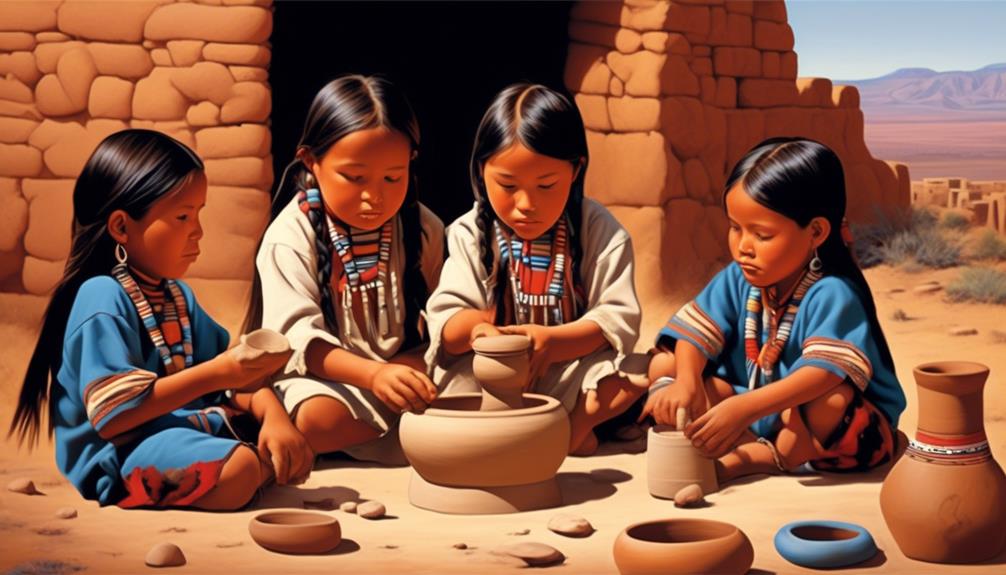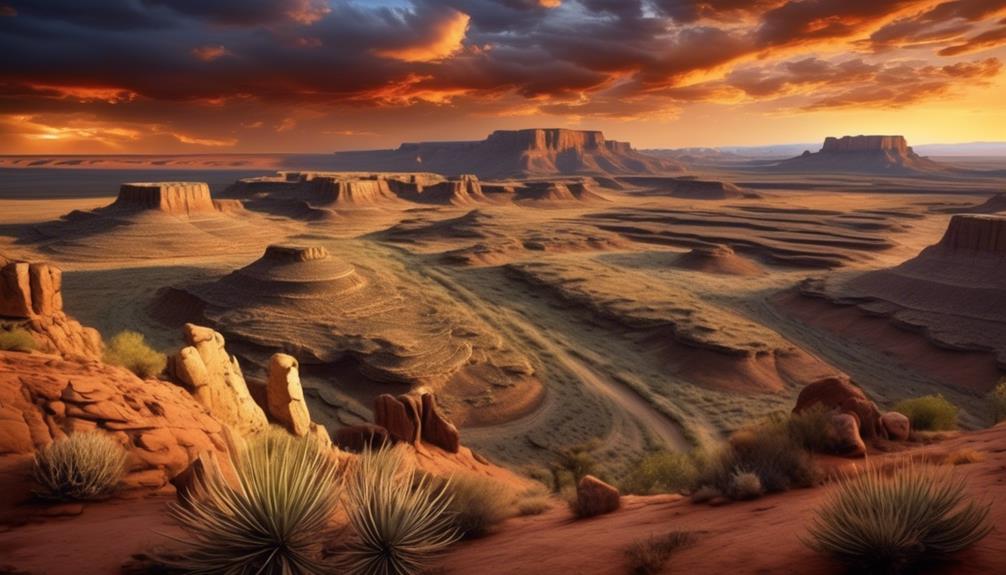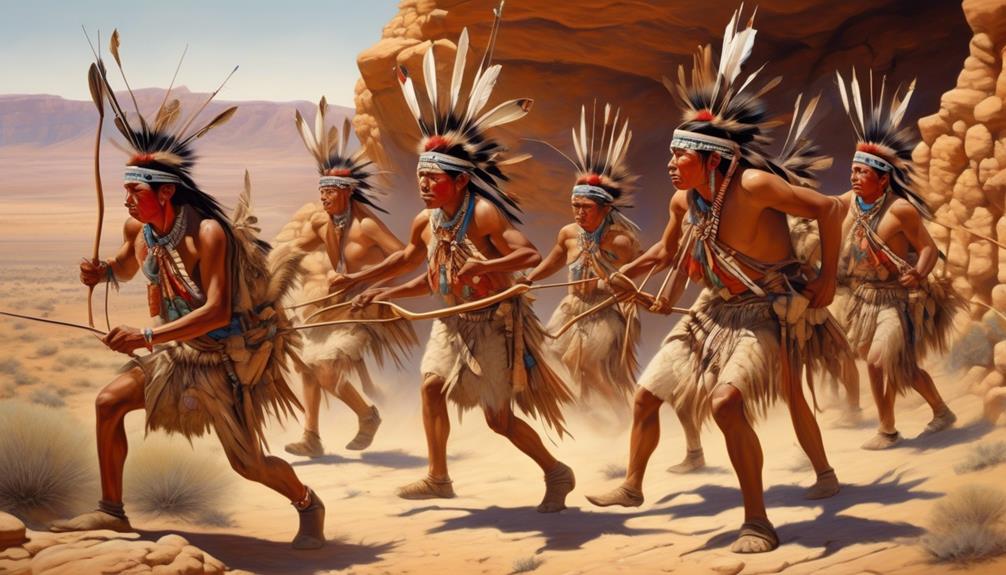The Hopi tribe, one of the oldest indigenous groups in North America, has lived in the same area for over a thousand years. Their connection to the land is deeply rooted in their culture and influences the unique characteristics of their community.
When considering the history and traditions of the Hopi people, understanding the geographic location and environmental factors of their region becomes essential. This sets the stage for exploring how these elements have shaped the tribe's identity and way of life.
Key Takeaways
- The Hopi Tribe lives in northeastern Arizona in a region that encompasses diverse landscapes of mesas, canyons, and arid plains.
- The region is located within the Colorado Plateau and has an elevation of around 5,800 feet.
- The Hopi reservation spans over 1.5 million acres and experiences relatively arid conditions with low precipitation levels.
- The tribe has developed sophisticated water conservation techniques and irrigation systems due to the scarcity of water in the area.
Geographic Location
The Hopi Tribe's region is located in northeastern Arizona, encompassing a diverse landscape of mesas, canyons, and arid plains. The geographic location of the Hopi Tribe places them within the Colorado Plateau, a region known for its unique geological formations and stunning vistas. Situated at an elevation of around 5,800 feet, the Hopi reservation spans over 1.5 million acres, providing a breathtaking backdrop for their traditional agricultural practices and cultural activities.
The climate patterns in the Hopi Tribe's region are characterized by relatively arid conditions with low precipitation levels and high temperatures during the summer months. Winters tend to be cold, with occasional snowfall due to the higher elevation. The scarcity of water in this region has significantly influenced the Hopi way of life, leading to the development of sophisticated water conservation techniques and unique farming practices suited to the arid environment.
Landscape and Environment
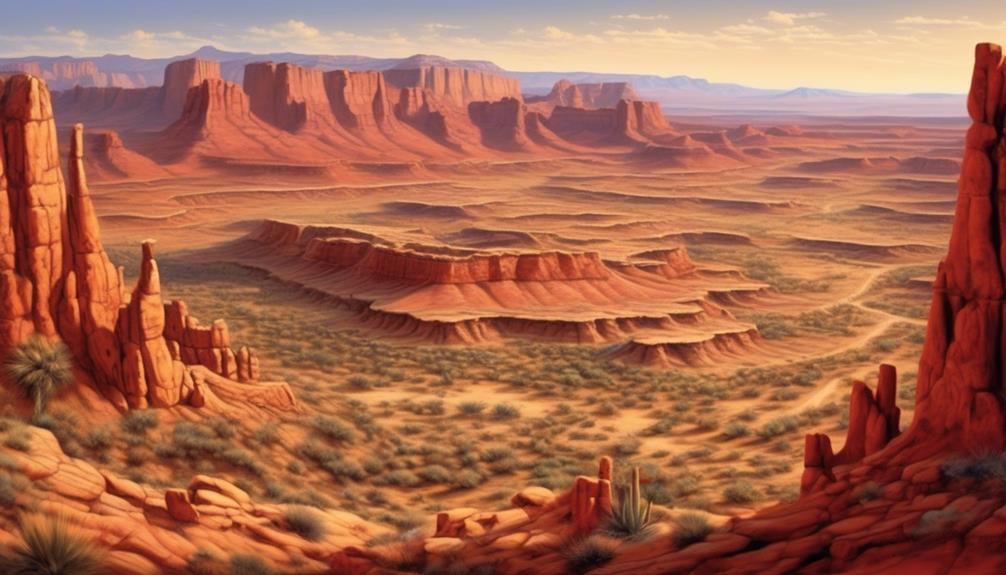
Nestled within the rugged terrain and under the vast skies of northeastern Arizona, the Hopi Tribe's region presents a diverse and captivating landscape that has shaped their traditional agricultural practices and cultural heritage.
The natural resources found in this area have been fundamental to the Hopi way of life for centuries. The land offers a mix of mesas, canyons, and arid plains, providing a challenging yet rich environment for farming. The Hopi people have ingeniously developed sophisticated irrigation systems, such as terraced fields and water-conserving techniques, to cultivate their crops in this semi-arid landscape.
The region's natural resources, including soil, water, and sunlight, have been carefully managed and utilized by the Hopi to grow corn, beans, squash, and other essential crops. Their deep connection to the land is evident in the ceremonial significance of agricultural practices within their culture. The landscape not only shapes their agricultural methods but also influences their spiritual beliefs and social organization.
The Hopi have sustained a delicate balance with the environment, demonstrating a profound respect for the natural world that sustains them.
Traditional Territories
Located within the rugged terrain and vast skies of northeastern Arizona, the traditional territories of the Hopi Tribe encompass a diverse and captivating landscape that has deeply influenced their cultural heritage and way of life.
The traditional territories of the Hopi Tribe aren't only a physical space but also hold profound cultural significance. These territories are intricately woven into the fabric of Hopi identity, providing the backdrop for their ceremonies, traditional practices, and spiritual beliefs. The land itself is considered a living entity, and each feature holds historical and spiritual importance.
From the mesas and buttes to the vast desert plains, every element of the traditional territories is intertwined with the collective memory and cultural legacy of the Hopi people. The landscape serves as a classroom, a source of inspiration, and a repository of traditional knowledge, passing down the wisdom of previous generations to sustain their way of life.
The traditional territories of the Hopi Tribe are a living testament to the enduring connection between land and culture, embodying the deeply rooted traditions and values of the Hopi people.
Connection to the Land
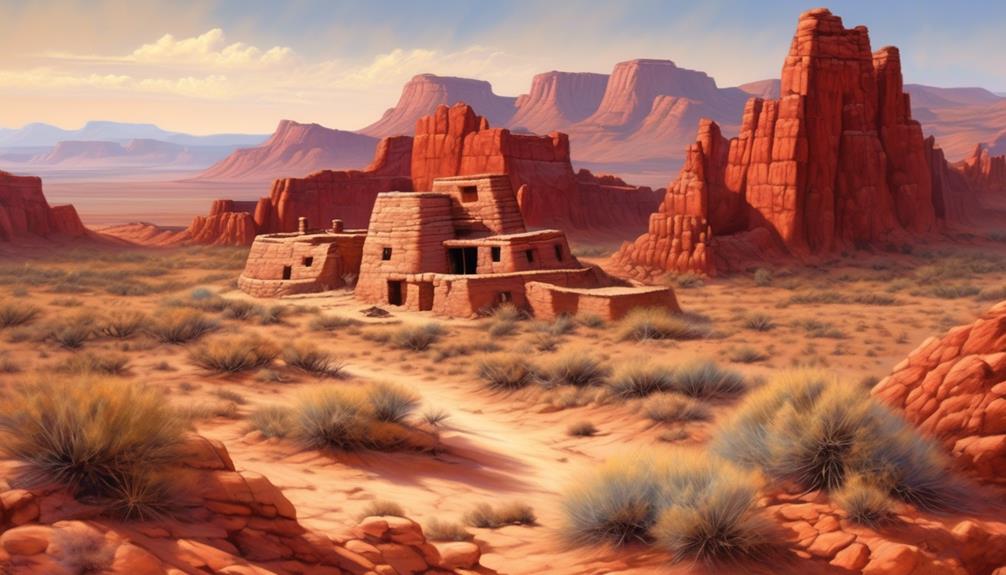
Deeply rooted in our cultural identity, the land of the Hopi Tribe plays an integral role in shaping our traditions and way of life. Our connection to the land is deeply intertwined with our cultural practices and holds immense spiritual significance for our community. The land isn't merely a physical space for us; it's a living entity that sustains and nurtures us, providing the foundation for our spiritual beliefs and traditions.
Cultural practices are intricately linked to the land, with many of our ceremonies and rituals centered around the natural elements and the cycles of the earth. Through these practices, we express gratitude for the land's abundance and seek to maintain harmony with the natural world. Our agricultural traditions, such as dry farming and the cultivation of corn, aren't only essential for our sustenance but also carry deep spiritual meaning, symbolizing our connection to the land and the cycle of life.
The land holds profound spiritual significance as it's believed to be the dwelling place of our ancestors and the spirits that guide and protect us. Our sacred sites, such as the Hopi Mesas, are revered as places of spiritual power and are central to our religious ceremonies and beliefs. The interconnectedness of our cultural practices and the spiritual significance we attribute to the land underscores the deep reverence and respect we hold for our ancestral territory.
Modern Day Reservation
The modern-day reservation of the Hopi Tribe encompasses a significant portion of northeastern Arizona and serves as the contemporary home for our community, preserving our cultural heritage and way of life.
The reservation location, nestled within the high desert landscape, consists of three mesas—First Mesa, Second Mesa, and Third Mesa—each representing a distinct village community. This geographic layout reflects the traditional organization of our people and facilitates the preservation of our unique customs and traditions.
The reservation isn't only a physical space but also a vital center for community development, where we focus on initiatives to maintain our language, uphold our spiritual practices, and sustain our agricultural traditions. The Hopi Tribal Council, in collaboration with various community organizations, works tirelessly to promote economic growth and educational opportunities for our people.
The reservation location isn't just a place of residence; it's the heart of our cultural identity and the foundation for our ongoing prosperity.
Frequently Asked Questions
What Are Some Traditional Hopi Ceremonies and How Are They Connected to the Landscape?
Traditional Hopi ceremonies are deeply connected to the landscape, reflecting our cultural preservation and environmental stewardship. Ceremonies like the Snake Dance and Powamu are tied to specific natural elements and seasonal changes.
Through these rituals, we honor and maintain our ancestral ties to the land, fostering a connection to the environment that's integral to our way of life. These ceremonies hold great significance in maintaining the balance between our people and the natural world.
How Has the Hopi Tribe's Relationship With the Land Evolved Over Time?
Our relationship with the land has evolved over time, carrying significant cultural importance for the Hopi Tribe. Our ancestors cultivated sustainable farming methods, respecting the earth's gifts.
As time progressed, the bond with the land deepened, influencing our spiritual and ceremonial practices. The landscape has remained integral to our cultural identity, shaping our traditions and values.
The evolution of our land relationship reflects our enduring connection to the natural world.
What Role Does Agriculture Play in the Hopi Tribe's Connection to Their Traditional Territories?
In our tribe, agriculture holds a sacred place, nurturing our spiritual connection to the land. Through our traditional practices, we sustain ecological balance and honor the significance of land use.
Agriculture isn't merely a means of sustenance; it's a reflection of our deep-rooted bond with our ancestral territories. It embodies our enduring respect for the earth and our commitment to preserving our heritage.
How Has the Modern-Day Reservation Impacted the Traditional Practices and Way of Life for the Hopi Tribe?
In considering the impact of modernization, it's essential to recognize the delicate balance between cultural preservation and adaptation within the Hopi tribe. The modern-day reservation has brought both challenges and opportunities, influencing traditional practices and ways of life.
It's a complex process as we strive to maintain our heritage while also embracing necessary changes. We must navigate the impact of modernization with careful consideration for our cultural identity and values.
What Are Some Examples of How the Hopi Tribe Has Worked to Preserve and Protect Their Traditional Lands and Natural Resources?
Preserving and protecting our traditional lands and natural resources is central to our Hopi way of life. Through traditional conservation practices and Indigenous stewardship, we've maintained a deep connection to the land.
Our efforts include sustainable farming methods, water conservation, and protecting sacred sites. We've also worked with communities and organizations to advocate for policies that respect and preserve our ancestral lands and resources.
Conclusion
In conclusion, the Hopi Tribe lived in the Southwestern region of the United States, primarily in what's now known as Arizona. Their traditional territories were characterized by a diverse and striking landscape, including mesas, canyons, and desert plains.
The Hopi people have a deep connection to their land, and their modern-day reservation reflects their ongoing commitment to preserving their cultural and environmental heritage.
Mary is a passionate writer who brings creativity and a fresh perspective to our team. Her words have the power to captivate and inspire, making her an essential contributor to our content. Mary’s commitment to storytelling and dedication to promoting Indigenous culture ensures that her work touches the hearts of our readers. We’re fortunate to have her as part of our team.



